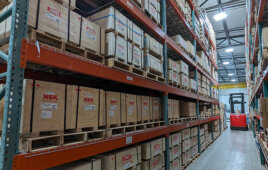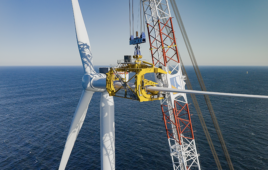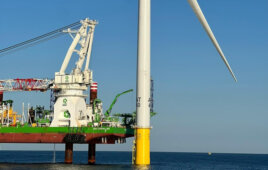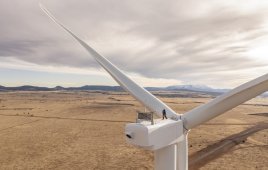These are rather specialized for particular components. For instance, coatings have been formulated for blades, tower, bolts, and magnets that might be used in generators. Coatings will become more important as more turbines are erected at sea.
In the wind industry, most coatings are for blades because they are constantly moving in air and exposed to the weather. Blades need coatings because their pitting can roughen the surfaces enough to create unstable harmonics that decrease a turbine’s efficiency, while increasing maintenance and repair costs. in steam turbines, pitting or corrosion can cause cracks in the metal. Coating wind turbine blades can prevent damage from pitting. Manufacturers of metal coatings suitable for the wind industry say they are durable, cost-effective, and eliminate common delamination and pitting problems. The coatings spray or roll- on for coverage that’s resistant to harsh weather. Manufacturers say the resins and metals can be applied to almost any substrate. The resulting surface is said to look and wear like cast metal without the traditional expense or weight. The metal coatings do not conduct electricity, are non-corrosive, and can be finished, sanded, polished, brushed, machined, or given a patina just as any forged or cast metal.
Another blade surfacing material uses fluoropolymers in a film application. The manufacturer reports advantages that include a 20-year performance–longer than traditional paint and gelcoats. The chemistry and nanotechnology in the material were developed to meet the needs of wind-turbine blades and has proven longevity in demanding architectural tasks. Performance advantages include UV stability, minimal dirt pickup, excellent abrasion resistance, and low reflectivity.
Trained operatives can apply the coating quickly and with little equipment. There are no sprays, solvents, or mixing so the surface quality is not at risk from human error and the working environment is far safer.
Another coating in flake and powder form, actually a high-temperature resistant thermoplastic, has a higher share of hydroxyl end groups to make it polyethersulfone-compatible with high-performance epoxy resins. Composites based on such high- temperature-resistant epoxy resins usually stay brittle unless modified with heat-resistant impact modifiers. A recent powder form allows using it more easily in a resin. What’s more, its use requires no solvents.
For fasteners, a thin-film metallic coating aimed at bolts made of A-490 steel has been evaluated according to a test method prescribed in standard IFI-144, “industrial Fasteners institute – Test evaluation procedures for Coating Qualification intended for Use on High-Strength Structural Bolts.” The investigation verified that the integrity of high-strength structural fasteners was not compromised by the metallic coating.
The coating is applied by first cleaning the bolts with an alkaline wash, mechanical blast only, and no acid pickling or electrolysis. Results of the test confirmed that the coating does not cause internal hydrogen embrittlement, nor does it promote environmental hydrogen embrittlement.
For electrical components, a custom ultra-thin conformal coating provides magnets and ferrite cores with excellent dielectric properties. These could be needed in offshore turbines. With a lower dielectric constant, lower dissipation factor, and high dielectric strength compared to industry-standard coatings, these are well suited for electrical insulation on miniature wire wound components. Ultra-thin coatings also provide protection against abrasion damage that may occur during the winding process. Finally, the coating’s dry lubricity (low coefficient of friction) is also beneficial in the winding process.
A few benefits to the ultra thin material include:
• Near eliminating faulty components while improving electrical performance. The use of adhesive tape as insulation between winding and metal component is a well established process. As components get smaller, however, applying tape becomes difficult, and in many instances, results in a lower yield of acceptable parts.
• The coating provides increased strength to the often fragile molded plastic ndFeB magnetic components. ndFeB material is also susceptible to corrosion from atmospheric moisture. The extremely low water-vapor-transmission properties provide excellent protection against corrosion.
• Ultra-thin coatings often also offer lower processing and labor costs because it is possible to coat many thousands of parts simultaneously using a tumble system during the vapor deposition process.
Filed Under: Components





hello, do you know who manufactures these types of coatings? I’m working on a development, and would require same type of performance capabilities.
thank you, Steve
Steve,
Check out our Supplier Pages. You will find Coating manufacturers there.